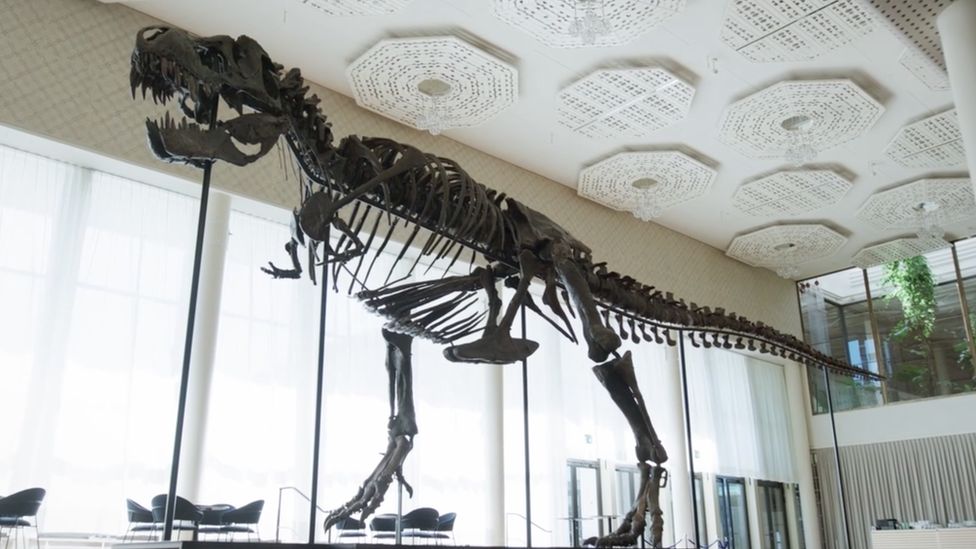In a rare and extraordinary event, a dinosaur skeleton, affectionately known as “Barry,” has gone up for sale in a Paris auction. This remarkable auction has garnered global attention, as experts and collectors alike vie for the opportunity to own a piece of Earth’s ancient history. In this article, we delve into the fascinating details of Barry’s auction, shedding light on the significance of this prehistoric find.
Meet Barry, the Dinosaur
Barry is not just any dinosaur; he belongs to the species Allosaurus, a carnivorous predator that roamed the Earth during the Late Jurassic period, approximately 155 to 150 million years ago. This particular Allosaurus specimen is exceptionally well-preserved and boasts an impressive size. Standing at around 13 feet tall and measuring about 30 feet in length, Barry is a formidable representation of the prehistoric world.
The Rarity of Allosaurus Fossils
Allosaurus fossils are relatively rare compared to some other dinosaur species, such as the Tyrannosaurus rex. This scarcity adds to the allure of Barry’s auction, making it a unique opportunity for paleontologists, museums, and private collectors to acquire a piece of natural history. Allosaurus is known for its distinctive features, including sharp teeth, powerful jaws, and a bipedal stance, which made it a fearsome predator during its time.
The story of how Barry came to be part of this auction is a tale of exploration and scientific curiosity. Barry’s fossilized remains were discovered in Wyoming, USA, a region renowned for its rich deposits of dinosaur fossils. The meticulous excavation and preparation of the skeleton took years of effort, involving skilled paleontologists and experts. The fact that Barry’s bones are largely complete and in excellent condition makes this find all the more exceptional.
The Auction in Paris
The decision to auction Barry in Paris has drawn considerable attention from around the world. The French auction house, Binoche et Giquello, is responsible for organizing this historic event. The auction not only serves as a platform for potential buyers to acquire Barry but also highlights the global interest in paleontology and natural history.
The Fierce Competition
Barry’s auction has attracted a diverse range of potential buyers, each with their own motivations for wanting to possess this remarkable dinosaur skeleton. Paleontologists are eager to study Barry’s bones, as they may provide valuable insights into the biology and behavior of Allosaurus. Museums hope to add Barry to their collections, allowing the public to marvel at this prehistoric wonder. Private collectors are enticed by the prestige of owning such a rare and awe-inspiring piece of Earth’s history.
While the auction of dinosaur fossils like Barry’s generates excitement and interest, it also raises ethical questions. Some argue that valuable fossils like these should belong to the public domain and be accessible for scientific research and education. Others contend that private ownership can lead to better preservation and care of these historical treasures. The ethical debate surrounding the sale of dinosaur fossils continues to be a topic of discussion within the paleontological community.
Preserving Earth’s History
Regardless of the outcome of Barry’s auction, the event serves as a reminder of the importance of preserving Earth’s history and the wonders of the natural world. Barry’s skeleton represents a connection to a distant past, offering a glimpse into the world of dinosaurs that once ruled the planet. As the auction unfolds, it remains to be seen who will become the fortunate owner of this incredible specimen, ensuring that Barry’s legacy endures for generations to come.
The auction of Barry, the Allosaurus dinosaur, in Paris is a momentous occasion that captivates the imagination of scientists, collectors, and enthusiasts worldwide. This rare opportunity to acquire a well-preserved dinosaur skeleton highlights the ongoing fascination with Earth’s ancient history and the enduring legacy of these magnificent creatures. Barry’s auction not only represents a chance to own a prehistoric marvel but also underscores the ethical discussions surrounding the ownership and preservation of invaluable fossils.


0 comment
Good post. I study something tougher on different blogs everyday. It is going to always be stimulating to read content material from different writers and observe just a little one thing from their store. I’d choose to make use of some with the content material on my blog whether you don’t mind. Natually I’ll offer you a link on your web blog. Thanks for sharing.